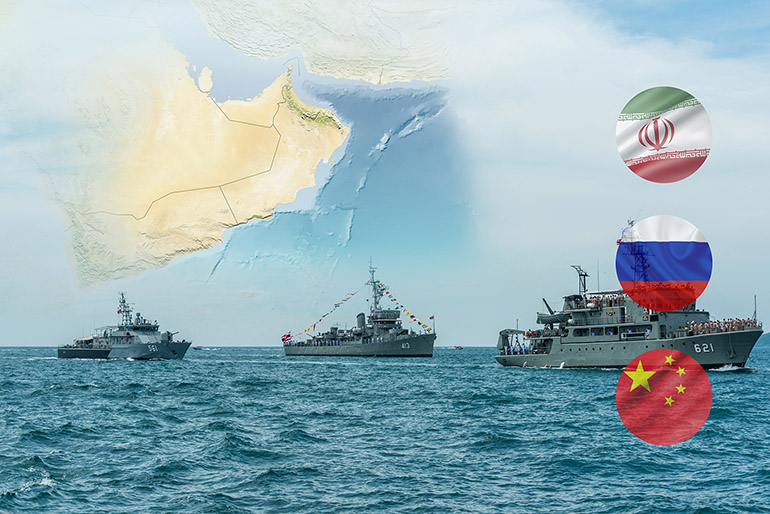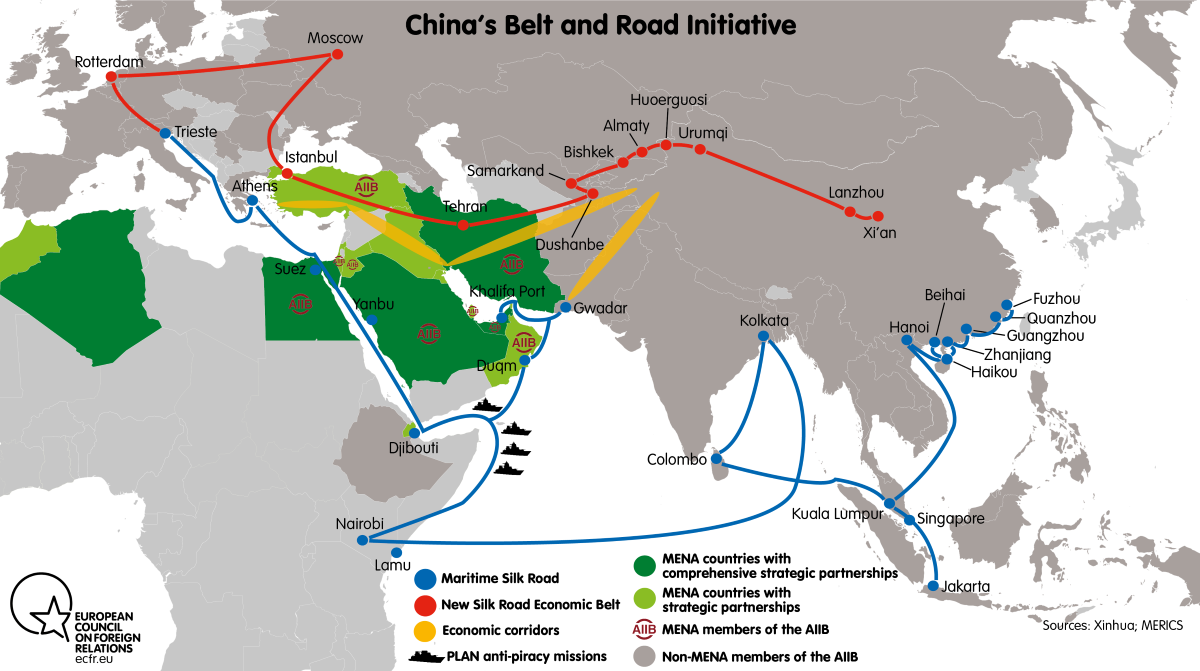
As an
alternative to the U.S. security umbrella, China envisages a broadening of
security arrangements in the Gulf region with the backing of Russia, based on a
collective security concept. A balanced security architecture in the Gulf could
generate cooperation and constructive rivalry, ultimately facilitating the
development of new political-security coalitions associated with the region. In this
context, the redefining of China’s, Russia’s and Iran’s regional roles and
strategies is pivotal for the formulation of any new political/security
arrangements relating to the Gulf region.
Any balanced
regional security architecture will depend significantly on great-power
involvement and the ways in which such powers are engaged in regional systems.
The prevailing doctrine in the West, especially towards the Arab world,
maintains that ‘balance of power’ is the major assurance of security and
stability in the Gulf region. The U.S. has itself tried to influence regional
dynamics through efforts to minimize Iran’s role within the context of the new
balance of power, but this has simply contributed to existing security dilemma
in the Gulf. A successful balanced solution will require the involvement of all
regional actors and most probably additional external powers.
In
the past decade, China has significantly increased its political,
economic and security footprint in the Middle East, specifically in the Gulf,
becoming the biggest trade partner and external investor for many countries in
the region. China’s growing economic presence is sure to expand to wider engagement
with the Gulf region, thus increasing China’s influence on regional stability
and political dynamics, especially in relation to issues such as surveillance
technology and arms sales. At the moment, when the long-standing U.S. influence
over the region shows signs of depreciation, policymakers are paying
attention to China’s position and objectives in the region, focusing on
China’s increased geopolitical competitiveness as it relates to political
dynamics in the medium to long-term, as well as its role within the framework
of a security architecture. The centrality of China’s economic cooperation and
development in the region is reflected in its establishment of the ‘Belt and
Road Initiative’, or a new ‘Silk Road’ as it were focusing on energy,
infrastructure construction, trade and investment in the region. The joint
projects between China and Iran exist in the context of China’s economic and
strategic influence across Eurasia through the ‘Belt and Road Initiative’ - an
immense aid and investment program. China hopes to develop
free-trade zones in Maku, in northwestern Iran; in Abadan, where the Shatt al-Arab
river flows into the Gulf; and on the island of Qeshm.

Figure 1: China’s Belt and Road Initiative, European Council on Foreign Relations (2020)
China in the Gulf: New cooperation
with Iran? The emergence of strategic
trilateral relations
China’s
non-interventionist strategy is based on a multipolar order in the Middle East
and partnerships with other states, promoting stability rather than the Western
vision of ‘democratic peace’. China may not want to strengthen its political
and security engagement in the region; however, it has no other choice. Despite
China’s growing footprint in the Gulf region, China maintains a cautious yet a
strategic security approach towards its partnership with Iran. This is based
on not alienating regional actors. Arguably the latter is one of the main
drivers for the ambitions and implementation of the comprehensive strategic
cooperation between Iran and China. China’s deep rivalry with the U.S. has
extended to participating in maritime security operations in the Strait of
Hormuz and involvement in a joint naval
drill with Iran and Russia in the Gulf of Oman and the northern Indian
Ocean in December 2019. Russia commended this as an unprecedented exercise in
naval cooperation and training. The four-day joint naval exercise involving
China, Russia and Iran was the first time the three states engaged in
cooperation of this type, as the three countries had only previously engaged in
bilateral exercises.
The rise in
U.S. strategic competition with China over trade in addition to the South China
Sea dispute has led to many shifts in China’s behaviour in the Gulf region.
Last month on July 6th, Iran’s Foreign Minister, Mohammad Javad
Zarif announced that Iran was
negotiating an agreement with China, allowing the two countries to be
equivalent strategic partners in the region. An 18-pages outline of the
agreement in Persian was leaked. This agreement is based on a 25-year comprehensive strategic partnership agreement
with billions of dollars’ worth of Chinese investments in energy, banking, transportation,
and cybersecurity in Iran. This deal also highlights the possibility of
Chinese-Iranian cooperation on weapons development and intelligence sharing,
and joint military drills. This has the potential to significantly expand U.S.-China
competition, as it plans to strengthen China’s relationship with Iran as
strategic partners, thus challenging the U.S. position in both the Gulf and
Indian Ocean regions.
The potential
security partnership between China and Iran could weaken and challenge the
Trump Administration’s efforts to isolate the Iranian government in response to
its nuclear and military activities, which could potentially exacerbate U.S-China
relations. In fact, the signed agreement was partly the result of the Trump
Administration’s aggressive policies towards Iran since leaving the 2015
nuclear deal, which included American sanctions and limiting access to the
international banking system for any company doing business with Iran. Waters
around Iran have however become a focal point for international tensions, with
the U.S. applying pressure to cut off Iranian crude oil and other trade ties.
The U.S. has isolated Iran economically, which has complicated relations with
China, the U.S.’ largest global trade rival. This decision was to stop five of
Iran’s main allies from obtaining Iranian oil including Japan, South Korea,
India and Turkey, all countries that have robust trade relations with the U.S.
By retracting its oil exemption, the Trump Administration is overstepping on
China’s energy security. Among all of these complications, China remains the largest
purchaser of Iranian oil
with increasing consumption, despite the U.S.’ stresses that it steadily
decreases the imports to zero. Iran’s desperation has pushed it into the arms
of China, which supports Iran by importing its oil and its technological needs
by the development of intelligence sharing and telecommunications, thus
creating a sense of alarm in Washington. Already, the U.S. regularly brushes against
Iranian forces in the busy Gulf waters and challenges China’s internationally
disputed claim to much of the South China Sea, with the Pentagon’s national
security strategy having outwardly recognised China as an adversary in this
context.
Balance of power and aspects of
great power competition – Is this cooperation biased towards Iran?
The strategic
impact of the 2003 U.S. invasion of Iraq has led to an increase of Iran’s
military presence in the Middle East and its influence in Iraq and the Levant.
The U.S. failure to act in Syria has also led to an increased Russian presence
and regional influence; this absence of a well-defined U.S. strategy in the
region has helped create a power vacuum that Russia
stepped in to fill as categorized by its growing influence in Turkey, its arm
sales to Iran, and its destabilising role in Libya. In addition, the U.S.
laissez-faire approach has opened the door for China to increase its presence
in the Red Sea and Djibouti. The U.S. is
increasingly focusing its efforts on competition rather than cooperation with
Russia and China. The U.S. – China trade war not only destabilises the global
economy, it also greatly reduces China’s
dependence on U.S. industries and stimulates China’s growing relationships with
third parties such as Russia and Iran. Deteriorating relations between China
and the U.S. will only continue to encourage China to forge ties with partners
considered undesirable by the U.S.; Russia and Iran are the two most
significant partners for China in this context.
The great power
competition is increasingly dividing the international community into two
camps, i.e. those who continue to support U.S. interests and those supporting
China and Iran, backed and supported by Russia. However there remain countries,
like Saudi Arabia for example, who maintain good relations with both the U.S.
and China simultaneously, with energy relations being at the heart of the
Saudi-China partnership. This close cooperation is evidenced through joint
projects such as, refining, petrochemicals and energy infrastructure between
Saudi Aramco and China. This Saudi-China partnership is focused on energy and
trade and less of a military-political alliance, with China being Saudi
Arabia’s top economic trading partner and importer of Saudi oil. Saudi Arabia’s
strategic political/military partner remains the U.S., and almost its entire
arms supply and military services comes from the U.S. and other Western states,
protecting Saudi Arabia’s national security and its territorial integrity. The
Gulf region therefore stands at the crossfire of U.S.-China tensions, which
will likely signify a geopolitical
trend of the upcoming decade, a difficult dynamic that the Gulf states
will have to seek to navigate.
Do trilateral China-Russia-Iran
relations support stability in the Gulf?
The trilateral
China-Russia-Iran naval drill demonstrates China’s support of Iran against
unilateralism and bullying in the region as well as an effort to follow the
basic norms of international relations emphasising non-aggression or
conflict-based interventions. The emphasis
on norms is key, as Chinese leaders are consistent in their opposition to the
use of force in international politics, preferring development-based solutions
over political and security pressure in the Gulf region. The naval drills
involve developing a series of commercial relationship that are not supported
by conventional military force. China has expressed that its interest in the
Gulf remains to promote a stable Middle East, through for example, developing
economic assistance in the region. This
is different from U.S. security assistance as China’s strategy is based on
economic ties with all regional actors, irrespective of existing rivalries. The
Chinese approach is driven by China’s energy interests and its ambitious
expansion that can be seen through the Belt and Road
Initiative, and for China to remain neutral in regional power discrepancies,
despite the strategic nature of the economic infrastructure under the BRI. This
allows China to grow economically in the Gulf region, without being sucked into
political and security conflicts. However, the Trump Administration’s policies
impacting the Middle East have led to a more divided region, for example,
through the complete pull-out of U.S. troops from Syria last December creating
a power vacuum in the region, only to reverse his policies and declare further military
deployments in the region to counter Iran six months later. The Trump
Administration has recognised Jerusalem as the capital of Israel, opposing UN
resolutions and the overwhelming majority position of the international
community. This in turn is increasing the process of China’s economic
engagement in the region. The timing of the joint exercise may have been
deliberate, given it was announced shortly after the drone strikes on Saudi
Aramco’s facilities in Abqaiq and Khurais last September, a potential
implication that China will support Iran should there be any military conflicts
between Iran and countries in the region. Iran had expressed the need for a
joint exercise to control vital waterways to combat piracy and terrorism, and
referred to this exercise as the new triangle of power on the seas. Chinese
officials described the joint
exercise merely as normal military cooperation.
Blue Sword
2019, the Chinese-Saudi bilateral naval exercise that took place the month
prior, involved the Saudi Royal Navy and the Chinese PLA Navy, and focused on
building mutual trust as well as developing cooperation, exchanging experiences
and improving the capability to combat maritime terrorism and piracy. The
rapprochement of Saudis and Iranians represents another signal that China
wishes to adopt a ‘balanced’ strategy in the region as it wishes to continue
leading trade and investments with ease. China aims to keep close ties with
Iran and Russia in the region in the context of its ongoing trade disputes with
the U.S. This is also strategically important for Iran, who stands to benefit
from such ties in the context of its current isolationism and U.S. maximum
pressure policies. However,
while it may seem that China is defending Iran in the absolute sense, one must
keep in mind that China’s alliances are predominantly designed to safeguard
China’s own capability to wield influence in the Gulf region.
In conclusion,
the current geopolitical dynamics in which the Middle East, and specifically
the Gulf finds itself, are an example of a broader regional security
architecture that stands to emerge within the context of great power
competition. The countries of the Gulf region should be prepared to act as
constructive partners with each other as well as with external powers– both in facing
regional challenges, as well as in dealing with global engagements with
superpowers such as China and Russia. This could be seen as defying the U.S.
position in the region, however the Gulf countries should be well positioned in
order to lead and balance the developing great power competition in terms of
regional and global security and stability. A way forward can be seen through a
collective and balanced security architecture, with each of the countries, both
the regional states and external powers having their own interests; however
what binds them together is a stable, prosperous and secure Gulf, which
collectively benefits all the state actors involved.
*Layla Ali is a Staff Researcher at the Gulf Research Center

